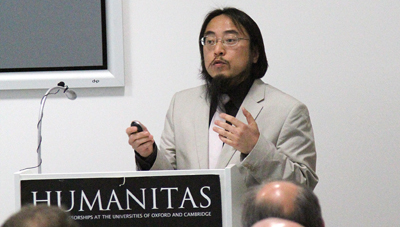Adam Chau: Text Acts: The Textographic Fetish in Religious Culture
Duration: 20 mins 35 secs
Share this media item:
Embed this media item:
Embed this media item:
About this item

| Description: |
Adam Chau (University Lecturer in the Anthropology of China, Cambridge)
The cultural significance of texts and writing in China has long been recognised. Traditionally, scholars in the fields of history, literature, religious studies, and philosophy study the contents of texts, while art historians study the artistic forms of writing (e.g. calligraphy). What has not received adequate attention is how certain texts exert their power in the social world not necessarily or simply through their rhetorical/discursive power or artistic beauty but more importantly through their sheer presence (e.g. seals, inscriptions on stone or cliff surface, tattooed characters, talismans, slogan banners, Maoist big character posters). The text disappears behind the textograph, which assumes a fetishistic power. In fact, some of these texts have acquired their power through condensing or morphing otherwise intelligible textual content into illegible figure (or motif). These texts act upon their audience and produce effects (e.g. recognition, submission, awe). More than, and sometimes rather than, reading these texts, the audience feel the force of their presence. I have called these acts of writing and inscribing text acts. This presentation will use talismans and other related genres of text acts to illustrate the ways in which writing catapults power and spellbinds its ‘readers’. |
|---|
| Created: | 2012-05-29 11:16 |
|---|---|
| Collection: | Humanitas |
| Publisher: | University of Cambridge |
| Copyright: | Glenn Jobson |
| Language: | eng (English) |
| Distribution: |
World
|
| Keywords: | CRASSH; Humanitas; Adam Chau; |
| Categories: |
iTunes - Humanities iTunes - Humanities |
| Explicit content: | No |
| Aspect Ratio: | 16:9 |
| Screencast: | No |
| Bumper: | UCS Default |
| Trailer: | UCS Default |
| Abstract: | Adam Chau (University Lecturer in the Anthropology of China, Cambridge)
The cultural significance of texts and writing in China has long been recognised. Traditionally, scholars in the fields of history, literature, religious studies, and philosophy study the contents of texts, while art historians study the artistic forms of writing (e.g. calligraphy). What has not received adequate attention is how certain texts exert their power in the social world not necessarily or simply through their rhetorical/discursive power or artistic beauty but more importantly through their sheer presence (e.g. seals, inscriptions on stone or cliff surface, tattooed characters, talismans, slogan banners, Maoist big character posters). The text disappears behind the textograph, which assumes a fetishistic power. In fact, some of these texts have acquired their power through condensing or morphing otherwise intelligible textual content into illegible figure (or motif). These texts act upon their audience and produce effects (e.g. recognition, submission, awe). More than, and sometimes rather than, reading these texts, the audience feel the force of their presence. I have called these acts of writing and inscribing text acts. This presentation will use talismans and other related genres of text acts to illustrate the ways in which writing catapults power and spellbinds its ‘readers’. |
|---|---|
Available Formats
| Format | Quality | Bitrate | Size | |||
|---|---|---|---|---|---|---|
| MPEG-4 Video | 640x360 | 1.84 Mbits/sec | 284.82 MB | View | Download | |
| WebM | 640x360 | 844.72 kbits/sec | 127.45 MB | View | Download | |
| Flash Video | 484x272 | 567.62 kbits/sec | 85.57 MB | View | Download | |
| iPod Video | 480x270 | 504.99 kbits/sec | 76.19 MB | View | Download | |
| MP3 | 44100 Hz | 125.05 kbits/sec | 18.73 MB | Listen | Download | |
| Audio Interchange File Format (AIFF) | 1.34 Mbits/sec | 206.49 MB | Listen | Download | ||
| Advanced Audio Coding (AAC) | 44100 Hz | 126.3 kbits/sec | 18.92 MB | Listen | Download | |
| Auto * | (Allows browser to choose a format it supports) | |||||

